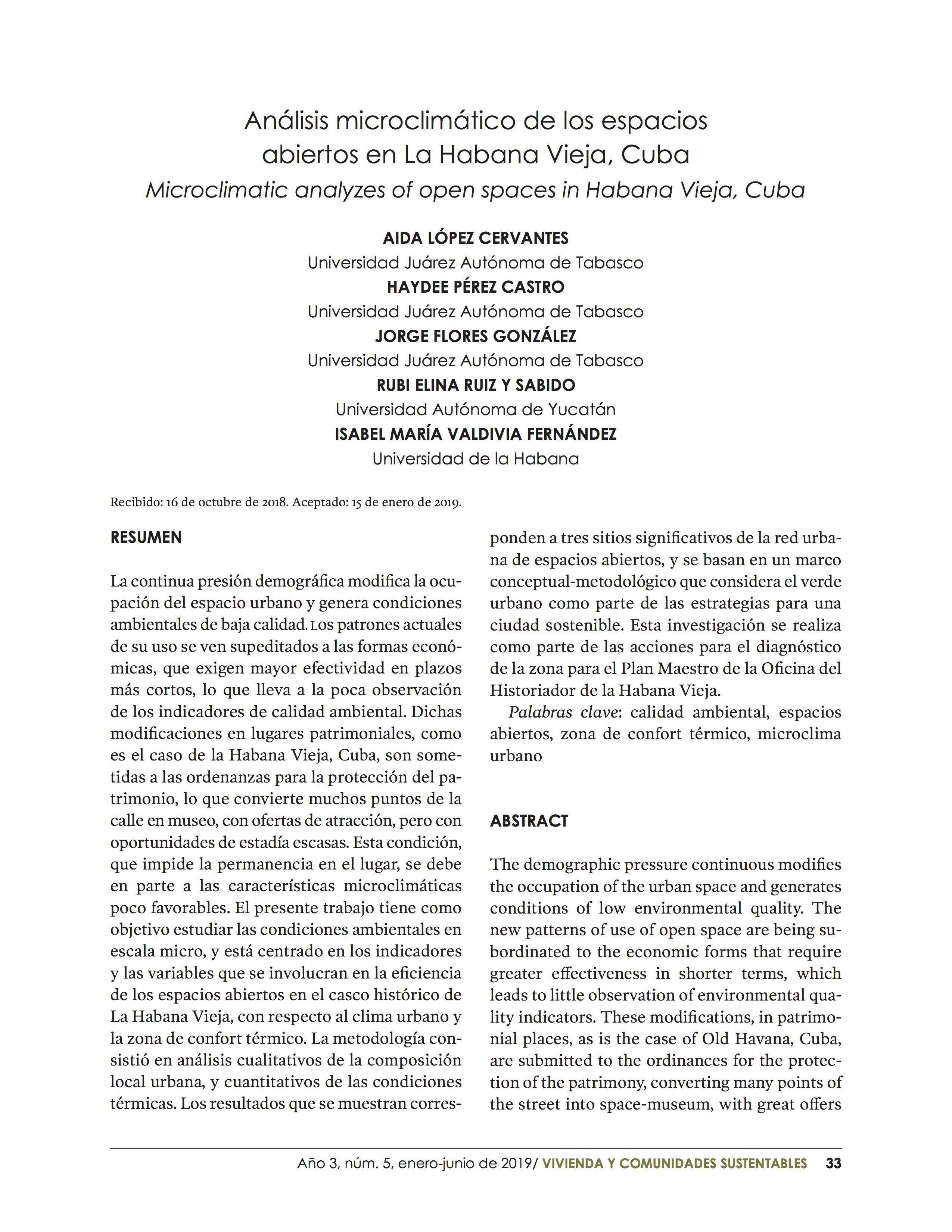Microclimatic analyzes of open spaces in Habana Vieja, Cuba
DOI:
https://doi.org/10.32870/rvcs.v0i5.99Keywords:
enviromental quality, open spaces, thermal comfort zone, urban microclimateAbstract
The demographic pressure continuously modifies the occupation of the urban space and generates conditions of low environmental quality. The new patterns of use of open space are being subordinated to the economic forms that require greater effectiveness in shorter terms, which leads to little observation of environmental quality indicators. These modifications, in patrimonial places, as is the case of Old Havana, Cuba, are submitted to the ordinances for the protection of the patrimony, converting many points of the street into space-museum, with great offers of attraction, but null opportunities of stay. The condition that prevents permanence in the place is due in part to unfavorable microclimatic conditions. The study focuses on the indicators and variables that are involved in the efficiency of open spaces in the historic center of Old Havana, with respect to the urban microclimate and the thermal comfort zone. The methodology consists of a qualitative analysis of the composition of the space and a quantitative of the thermal conditions. The results shown correspond to three significant sites of the urban network of open spaces, based on a conceptual-methodological framework that considers green spaces as part of strategies for a sustainable city. This investigation is carried out as part of the actions for the diagnosis of the area for the Master Plan of the Office of the Historian of Old Havana.Metrics
References
Convención Marco de las Naciones Unidas sobre el Cambio Climático (2015), paris_agreement_spanish.pdf, 12 de diciembre. Disponible en: http:/ www.cop21. Consultado: 10 de julio de 2017.
https://doi.org/10.5377/cultura.v21i67.2496
Gobierno del Distrito Federal (2010), Lineamientos de sustentabilidad para el diseño de espacios abiertos en el Distrito Federal, México, GDF.
Gómez, N. R. (2010), "Parámetros (ps) sostenibles en el planeamiento y diseño ambiental del espacio microurbano", Pluris, pp. 40-52.
Guzman, M. O. (2014), "Confort térmico en los espacios públicos urbanos. Clima cálido y frío semi-seco", Habitat Sustentable, pp. 52-63.
Hall, E. T. (1966), La dimensión oculta, New York.
Hernández, A.; Fariña, J.; Fernández, V.; Gálvez, M.; Hernández, A. y N. Urrutia (2013), Manual de diseño bioclimático urbano. Recomendaciones para la elaboración de normativas urbanísticas, Bragança, Portugal, Instituto Politécnico de Bragança.
Higueras, E. (1998), Urbanismo Bioclimático. Criterios medioambientales en la ordenación de asentamientos, Madrid, Instituto Juan de Herrera.
Lara, G. M. (2011). Evaluación del bienestar térmico a través de la temperatura operativa, Servicio de Higiene Industrial y Salud Laboral, Murcia, Instituto de Seguridad y Salud Laboral.
López, A. (2001), Diseño térmico de espacios exteriores, Universidad Autónoma de Yucatán, posgrado de Arquitectura, Mérida.
Martilli, A. (2010), Modelización del clima urbano a mesoescala, España, CIEMAT.
Morin, E. (2003), Introducción al pensamiento complejo, Barcelona, Gedisa.
Olgyay, V. (1998), Design with Climate, Barcelona, Gustavo Gili.
ONU-Habitat (2016), The New Urban Agenda. Disponible en: http:/www.habitat3.org/the-new-urban-agenda. Consultado: 2 de abril de 2018.
--- (2018), Ciudades-desarrollo sostenible. Disponible en: www.un.org/susteinabledevelopment/cities/. Consultado: 13 de agosto de 2018.
Serra, F. C. (1995), Arquitectura y energía natural, Barcelona, Universidad Politécnica de Catalunya.
UNE-EN-ISO 7730 (2006). Ergonomía en ambientes térmicos. Determinación analítica e interpretación del bienestar térmico mediante el cálculo de los PMV y PPD, y especificaciones para el bienestar térmico.

Downloads
Published
How to Cite
Issue
Section
License
Copyright (c) 2019 Vivienda y Comunidades Sustentables

This work is licensed under a Creative Commons Attribution-NonCommercial-NoDerivatives 4.0 International License.
The authors who publish in this journal accept the following conditions:
In accordance with the copyright legislation, Sustainable Housing and Communities recognizes and respects the moral right of the authors, as well as the ownership of the patrimonial right, which will be transferred to the University of Guadalajara for its dissemination in open access. Sustainable Housing and Communities does not charge authors for submitting and processing articles for publication. Authors may make other independent and additional contractual agreements for the non-exclusive distribution of the version of the article published in Sustainable Housing and Communities (for example, include it in an institutional repository or publish it in a book) as long as they clearly indicate that the work is published for the first time in Sustainable Housing and Communities.





